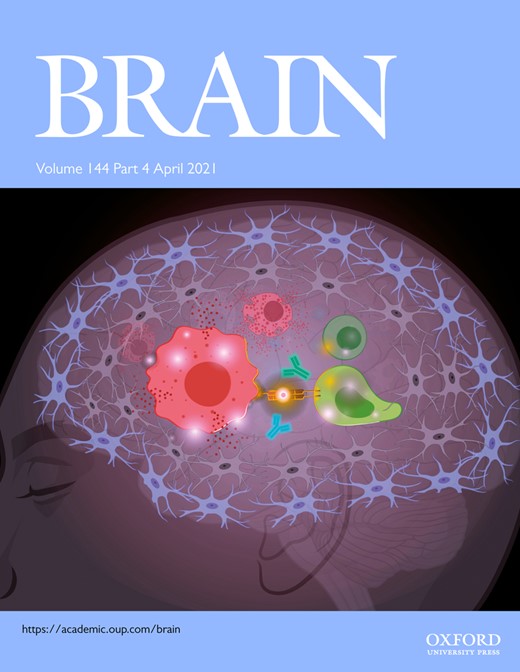-
PDF
- Split View
-
Views
-
Cite
Cite
Diederik F Janssen, The etymology of ‘neurology’, redux: early use of the term by Jean Riolan the Younger (1610), Brain, Volume 144, Issue 4, April 2021, Page e38, https://doi.org/10.1093/brain/awab023
Close - Share Icon Share
In an excellent recent article, Mehta et al.,1 following the OED and practically all historians of neuroscience, trace the term ‘neurologia’ back to usage by Thomas Willis in 1664, venturing that Willis is also to be credited with its prefix ‘neuro-’. Willis indeed arrived at the term, and was posthumously credited with it in early medical lexica, specifically Castelli.2,(p625) The term, indeed the Greek rendering νευρολογία, was credited to him by influential English physician Richard Lower.3(p114) But Willis was not the first.
‘Neurologia’ appears twice in Anatome corporis humani, by eminent anatomist Jean Riolan the Younger (1580–1657). This work is incorporated in the posthumous Opera omnia of Jean Riolan the Elder (1539–1605).4,(pp160,164) The pertinent sections, on brain and eye anatomy,4,(pp160,164) reappeared in senior’s Opera cum physica, tum medica.5(pp549,552) These works seemingly hold the earliest attestations of ‘neurology’, though 16th century attestations cannot be ruled out given these early 17th century ones. ‘Psychologia’, for instance, has multiple attestations as early as 1525.
‘Neurologia’ does not appear in work by either Riolan senior or junior before 1610, and the term seems only to cross-reference sections on the nerves. In Riolan junior’s 1608 nomenclature of the division of anatomy (in a tract that the 1610 text expanded), the term does not yet occur, though various discipline-forging neologisms (myologia, splanchnologia) appear next to established ones,6,(p16) and reappear in 1610.4,(p118) Where it had earlier meant phlebotomy, Riolan had ‘angeiologia’ (or ‘angiologia’) denote the anatomy of all purported vessels: veins, arteries, and nerves.6,(p237) ‘Neurologia’ thus, if anything, appears Riolan junior’s tentative subdivision of ‘angeiologia’ as he was using it. Riolan’s 1608 chapter on angeiologia had two subchapters, ‘on the nerve’ (De nervi) and on spinal nerves,6,(pp260-77) the first of which features the paraphrasing expression nervorum doctrina, ‘doctrine of the nerves’ (a paraphrase also seen in the 1681 English translation of Willis, as Mehta et al.1 observe). Riolan was a proficient angiologist, known for the Arc of Riolan.
Neurologia reappears in multiple early 17th century texts following this expanded anatomical nomenclature, indeed before Willis. Riolan the Younger reused ‘neurologia’ in a later work entitled Anthropographia,7(p448) another neologism meaning descriptive or topographic human anatomy. This explains its reappearance in Marin Mersenne’s Quæstiones celeberrimæ in Genesim,8(p1203) in a section on the sciences. An unacknowledged edit of this section, also including the term, is found in Volume 1 of Jean Lalemandet’s Decisiones philosophicae.9(p427) In both works, neurologia (de neruis) is made to name one of the subdisciplines of Riolan’s Anthropographia. In Mersenne, it is distinguished from myologia (muscles), osteologia (bones), artereologia (arteries) and phepsologia (veins). The last two terms appear neologisms. In Lalemandet, neurologia is distinguished from myologia, osteologia and chirurgia. Mersenne, per Riolan, thus definitively teased apart the science of the ‘vessels’ (vasa) by the three types of vessels. Neurologia also appears in Italian anatomist Marco Aurelio Severino’s (1580–1656) comparative anatomical work Zootomia democritæa,10(p148) here in the following neo-Riolanian line-up: ‘Nevrologia, Sarcologia, Angiologia, Splangnologia’. These authors were close-reading Riolan: not all anatomists picking up on Riolan’s terminology picked up on ‘neurology’. Even today, Riolan is little known to have piloted the term. We must add that the French cognate Neurologie already appeared in the preface of Jean Durelle's Onomatologie chirurgique (1644), denoting discours des nerfs.
To sum up and to conclude: contrary to widespread belief, Willis was not the first to use the term ‘neurology’. It is hard to say whether Willis borrowed it from Riolan the Younger or from a later source. He seemingly never cited either of the Riolans. As Riolan the Younger, Willis did not claim to be citing a new term, and never properly defined it. Coinage and usage of the term reflect an ongoing anatomical dispute: whether nerves were vessels, and/or whether the three types of vessels were entitled to their own discipline.
Data availability
Data sharing is not applicable to this article as no new data were created or analysed in this study.
Competing interests
The author reports no competing interests.
References


